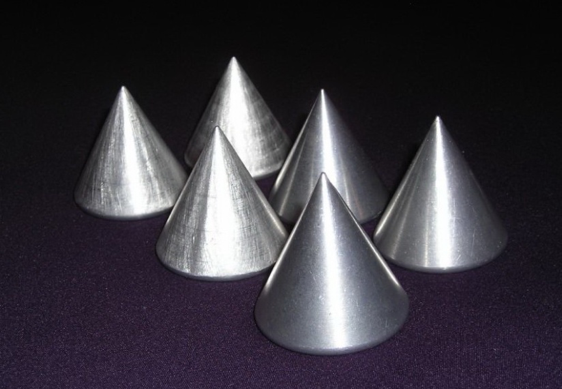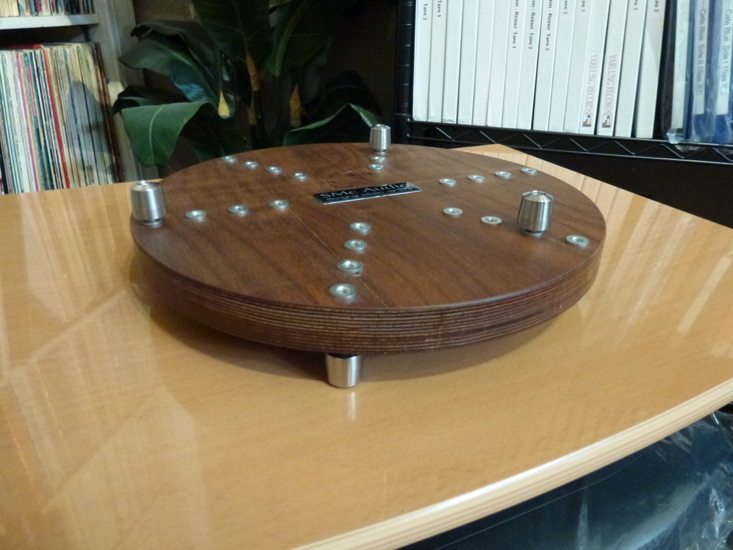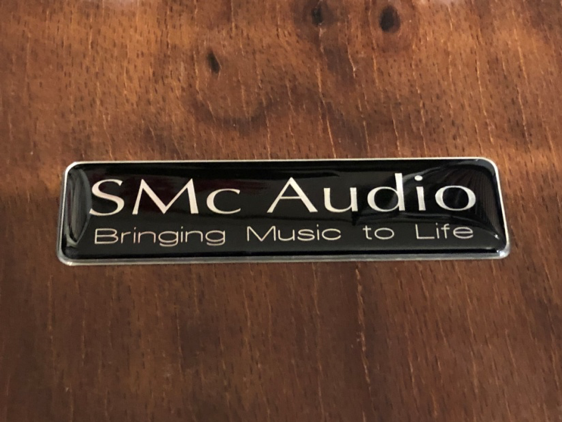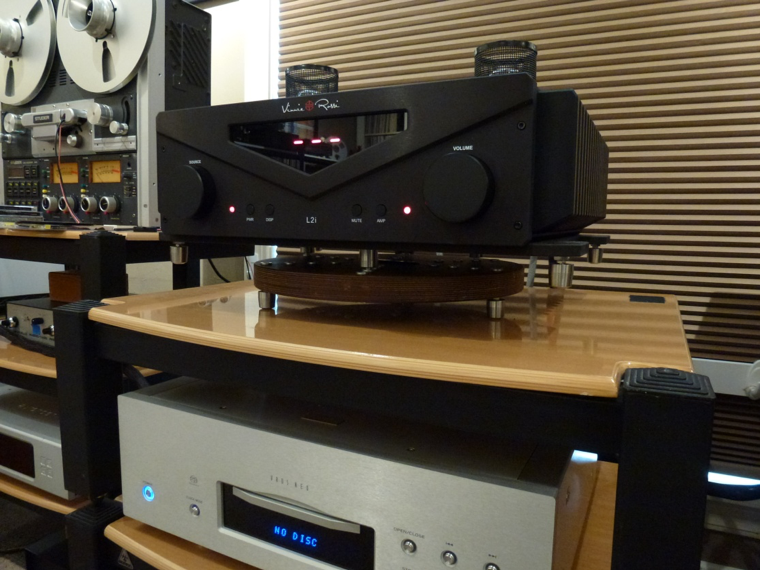No, this isn’t an article about some odd contraption left by ancient aliens or some recently discovered weapon from World War II. It is, however, a review of the SMc Audio Panzerholz UFO Isolation Base, one of the best audio isolation products to come through my listening room in quite some time.
What is the Panzerholz UFO Isolation Base?
The Panzerholz UFO Isolation Base is a component isolation product that you place under your preamp, amp, DAC, speaker, etc. It is a disc that is 25mm thick (that’s a hair shy of an inch), and it is available in a 10-inch or 12-inch version. They are made of Panzerholz wood, which is denser, with lower transmissibility and higher internal damping than other types of wood. It is used primarily for audio components and to make bullet-proof door panels for automobiles. No, I’m not kidding.
Six star-like arrays of ¼-20 threaded inserts are on the top and bottom of the disc. Three Stillpoints Mini feet reside on the top and three on the bottom. And, I hear you asking, “Why all the arrays and all of the threaded inserts? And, why is it round?” I’ll address these questions and more a bit later in the review.
Steve McCormack is SMc Audio
The first question to address, however, is who invented this product? SMc Audio may not be a familiar brand for many of you. However, the man behind it, Steve McCormack, has quite a history in the audio world.
My first contact with Steve extends back to my retail days in the late ’70s early ’80s when I was an Oracle turntable dealer. Steve was working for Oracle and was traveling around the states training dealers on how to set up the finicky Oracle Delphi. He spent an entire day with me and patiently taught me the ins and outs of turntable setup. To this very day, I still use much of what he taught me.
The Mod Squad
After his time with Oracle, Steve decided that he could offer modifications to existing products. This would raise their level of performance and provide great value to customers. So, he opened his aptly named company, The Mod Squad, in the early ’80s.
Among the many products he offered modifications for, I specifically remember his work on the first Meridian Pro CD player, the Quad 405 amplifiers, and his involvement with the Spatial Coherence Preamp. By the way, that may be my all-time favorite name for a preamp.
Then TipToes Happened

At The Mod Squad, Steve introduced the audio world to component isolation when he developed TipToes. Yes, that’s where these aluminum cones you set under your equipment came from originally. They were said to have a positive impact on the sound. I cannot impress upon you how outlandish this concept was in the early ’80s. It was as outlandish as the ridiculous notion (at the time) that audio cables could make a difference in sound quality.
Steve was involved with lots of other products. Over time he brought out his own line of audio components under the McCormack Audio moniker. He had a very successful run with McCormack Audio, and he eventually sold the company to Conrad Johnson who continued with the production of McCormack products.
Fast Forward
Steve later opened SMc Audio as a business focused on upgrading the thousands of McCormack amps and preamps that are out in the field. This is where he resides today, and they stay quite busy. They are highly respected for their work and the value it offers McCormack owners.
By the way, if you have a McCormack amp, preamp, or DAC, drop Steve a note to see what the latest upgrades for it are. It is one of the most cost-effective ways I know to raise the performance of your system.
In the last decade, Steve has also produced the world-class VRE-1 preamp and the critically acclaimed Nexus AC power conditioner. They are both considered some of the very best products available in their category. Suffice it to say, Steve knows what he is doing.
Behind the Design
Recently, Steve contacted me to see if I would be interested in reviewing his latest product offering, the Panzerholz UFO Isolation Base. He was pleased with the results and wanted to see what an independent listener would find. I could hear in his voice that he was quite excited about the product. Knowing Steve, I was happy to take it on, but first I asked him to give me a bit of background on the product and its development.
Moving Beyond Footers
“Your readers may recall that I developed the original TipToes cone feet back in 1982, so you could say that I’ve had some experience with component footers. Since that time, the idea has taken on a life of its own, and performance-enhancing footers have become commonplace throughout the audio industry.
A tremendous amount of creative development has gone into this product category, and there are now wide varieties to choose from at all price levels. This same train of thought has led to the development of highly sophisticated equipment racks and stands that offer genuine performance benefits and enhanced musical enjoyment.
Changing the Sonic Character
For me, the main lesson has been that changing the physical interface between your equipment and the surface it sits on will affect its sonic character. This has led to products made from all sorts of materials, both hard and compliant, being used to create a lot of different footer designs, each with its own sonic signature.
This experience got me thinking about the materials used to build my equipment chassis, which led to experiments with different metals, and then to non-metallic options. I’ll make a very long story mercifully short and just say that this ultimately led to the creation of my VRE-1 preamplifier in a custom Corian chassis. The performance is exceptional, but the chassis is very difficult to produce. Every material has its trade-offs,” Steve said.
Discovering Panzerholz
Moving on with the story, Steve explained, “A few years ago I had the good fortune to meet Rick Brown of Hi Fi One, who was then handling a speaker called the Kawero, from Kaiser Acoustics in Germany. The cabinetry of this exceptional speaker is made entirely from a densified-wood product called Tankwood, or Panzerholz, which resulted in a cabinet that is heavy and mechanically inert, or resonance-free. The more I found out about this material, the more I was convinced that it would be a great choice for building my chassis. It is dense and rigid, but with excellent self-damping of high-frequency vibrational energy. It can be CNC machined with precision, and in fact, is more like aluminum or brass in this regard. The high density makes it relatively heavy and the 25mm-thick panels are difficult to handle, but I felt it would be worth the effort.
All of this background got me thinking about the design of a new class of vibration isolation platform – something between a footer and a larger, more traditional platform or shelf, that would leverage the benefits of both Panzerholz and Stillpoints isolation technology in a single unit. After a few prototype experiments, voilà! – the Panzerholz UFO Iso Disc was born. It combines performance, convenience, and adaptability in a single unit. It is what I call “programmable” in the sense that the layout of the 3-point footprint on both sides can be adjusted to best fit your equipment and the surface it sits on. They are easy to install, position, and experiment with for best results.”
But Why is It Round?
When Steve first described the Panzerholz UFO Isolation Base to me in that initial phone call he told me that it is round. “Why round?” I asked.
Steve explained, “It is not just the ability to adjust the layout of the Stillpoints to best fit your equipment, but also the ability to experiment with moving and rotating the disc to find the ‘sweet spot’ for the best sonic improvement. People are accustomed to seeing rectangular shelves and platforms, and if the product was rectangular nobody would try to rotate it as an experiment. I may yet make some rectangular UFO Iso Bases out of Panzerholz, but I started with discs because I think that is the most versatile shape for adjusting and tuning.”
I’ll admit that I was a bit skeptical, but once I had it in hand and actually used it, I came to the conclusion that the round shape was actually a very smart move on Steve’s part. I’ll also add that it is a universally easy shape to put under a variety of components.
In Part 2 of this review, I’ll cover the sonic improvements. So, watch for this post to be online soon.
Isolation Base Details and Price:
The Panzerholz UFO Isolation Base is offered in 10” and 12” versions. Sales are direct from SMc Audio, and the cost is $1,400 for the 10″ base, and $1,600 for the 12″ base, including ground shipping within the continental US.
Each isolation base will come with 6 pieces of the Stillpoints Ultra Mini Foot (3-up and 3-down), a hex driver for installation and adjustment of the Stillpoints, and 3 pieces of a steel spike with 1/4-20 thread for use on a carpeted floor.
Contact Information:
Steve McCormack
760-908-5263
www.SMcAudio.com
SMcAudio@cox.net





looks to shakey to me I’ll read over it again i missed the unstable part
Quite to the contrary.. The “tripod” configuration along with the ability to increase or decrease the radius
of support and the fact the the upper 3 supports are offset from the bottom three, all make for a very stable platform.